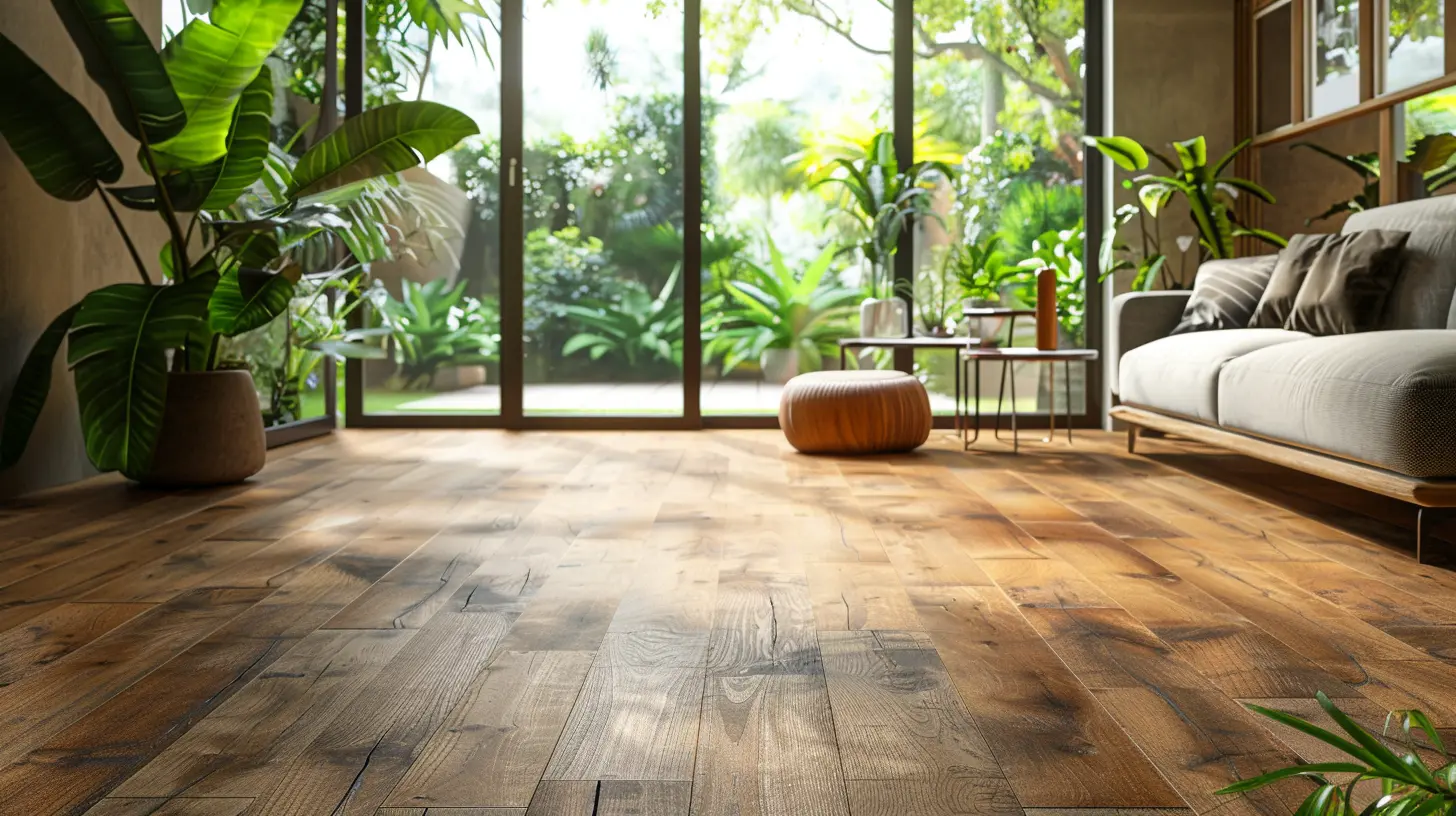Sustainable Flooring Options That Are Perfect for Green Homes
11 November 2025
When it comes to designing an eco-friendly home, flooring is often overlooked. But the truth is, your choice of flooring can have a massive impact on the environment. Traditional flooring materials—like synthetic carpets and vinyl—often contain harmful chemicals and contribute to deforestation and pollution.
So, what’s the better alternative? Sustainable flooring. If you’re looking for stylish, durable, and eco-friendly flooring options, you’re in the right place. Let’s dive into some of the best sustainable flooring options that will make your home not only greener but also more beautiful. 
1. Bamboo Flooring: The Fast-Growing Wonder
Bamboo flooring is one of the most popular choices for eco-conscious homeowners, and for a good reason. Unlike traditional hardwoods, which take decades to regenerate, bamboo grows incredibly fast—some species can grow up to 3 feet a day!Why Bamboo is a Sustainable Choice:
✅ Rapid Renewal – Bamboo is ready for harvest in just 3-5 years, unlike oak or maple, which can take up to 60 years.✅ Durability – It’s as strong (if not stronger) than traditional hardwoods.
✅ Natural Aesthetics – Available in various colors and styles, it fits effortlessly into modern and classic designs.
Potential Downsides:
❌ Not Always Sustainably Sourced – Some manufacturers harvest bamboo irresponsibly. Always look for FSC (Forest Stewardship Council) certification.❌ Moisture Sensitivity – Bamboo can warp in very humid or dry conditions.
If you want a flooring option that’s as tough as hardwood but more sustainable, bamboo is a fantastic choice. 
2. Cork Flooring: Soft, Renewable, and Hypoallergenic
Cork flooring might not be as mainstream as hardwood or tile, but it’s an excellent green option. It’s harvested from the bark of the cork oak tree, which regenerates every 9 years—no trees are cut down in the process!Why Cork is a Smart Choice:
✅ Sustainably Harvested – Cork trees continue to grow even after their bark is stripped.✅ Comfortable & Soft – It has a slight cushioning effect, making it more comfortable underfoot.
✅ Great Insulator – Cork naturally retains heat and absorbs sound, making it ideal for cozy, quiet homes.
✅ Mold & Mildew Resistant – A great option for allergy sufferers.
Potential Downsides:
❌ Prone to Dents – Heavy furniture can leave marks.❌ Requires Sealing – To protect against moisture damage, cork flooring needs to be sealed periodically.
For anyone who loves a warm, soft, and eco-friendly flooring option, cork is a fantastic bet. 
3. Reclaimed Wood: Giving Old Timber a Second Life
If you adore the look of hardwood but want an environmentally responsible choice, reclaimed wood is the way to go. This type of flooring is made from old barns, factories, and even wine barrels, giving the wood a second life instead of letting it go to waste.Why Reclaimed Wood is a Green Choice:
✅ Reduces Deforestation – No new trees are cut down.✅ Unique Character – Aged wood offers a weathered, rustic charm you won’t find in freshly cut timber.
✅ Durability – Older wood tends to be stronger due to its dense grain structure.
Potential Downsides:
❌ Can Be Pricey – Since reclaimed wood requires processing, it can be more expensive than new hardwood.❌ Inconsistent Sizing – Because it’s salvaged from different sources, planks may not be uniform.
If you want a floor with history, charm, and sustainability, reclaimed wood is the perfect pick. 
4. Recycled Tile: Beauty from Waste
Who knew that old glass bottles and industrial scraps could create stunning floors? Recycled tile, made from repurposed materials like glass or porcelain, is both a stylish and sustainable flooring option.Why Recycled Tile is a Winner:
✅ Uses Existing Materials – Reduces landfill waste by repurposing materials.✅ Durable & Water-Resistant – Perfect for kitchens, bathrooms, and outdoor areas.
✅ Endless Design Options – Available in a vast range of colors, shapes, and patterns.
Potential Downsides:
❌ Cold Underfoot – Tile can feel chilly, especially in colder climates.❌ Hard Surface – Not ideal if you want a cushioned surface for comfort.
Recycled tile is an excellent choice for homeowners who want durability, beauty, and sustainability wrapped into one.
5. Linoleum Flooring: The Forgotten Eco-Friendly Option
Many people confuse linoleum with vinyl, but they couldn’t be more different. Linoleum is made from natural materials like linseed oil, cork dust, and wood flour, making it a biodegradable and non-toxic flooring choice.Why Linoleum is a Smart Choice:
✅ Long-Lasting – It can last over 40 years with proper care.✅ Made from Natural Materials – 100% biodegradable and free from harmful chemicals.
✅ Low Maintenance – Easy to clean and doesn’t require harsh cleaners.
Potential Downsides:
❌ Color Changes Over Time – Linoleum can develop a yellowish tint in prolonged sunlight.❌ Requires Sealing – Some varieties need periodic sealing to maintain moisture resistance.
If you want a flooring option that’s both durable and low-maintenance, linoleum is worth considering.
6. Concrete Flooring: The Unexpected Eco Hero
Concrete might not be the first thing that comes to mind when you think about sustainability, but hear me out. Polished concrete flooring utilizes the existing foundation of a home, reducing the need for additional materials. When done right, it’s an incredibly eco-friendly choice.Why Concrete is a Sustainable Option:
✅ No Extra Materials Needed – Uses the foundation as the floor.✅ Durable & Long-Lasting – Virtually indestructible, reducing the need for replacements.
✅ Energy Efficient – Retains heat during winter and stays cool in summer, reducing energy costs.
Potential Downsides:
❌ Hard Surface – Not the most comfortable flooring to stand on for long hours.❌ Can Feel Cold – Requires area rugs in colder climates for added warmth.
If you love minimalist, industrial-style interiors, polished concrete is a sleek, eco-friendly flooring solution.
7. Wool Carpet: Soft, Warm, and Natural
If you love the cozy feel of carpet but hate synthetic fibers, wool carpet is the perfect alternative. Wool is a natural and renewable material that offers warmth, comfort, and excellent insulation.Why Wool Carpet is a Great Choice:
✅ Sustainably Sourced – Sheep produce wool annually.✅ Biodegradable – No synthetic materials, making it 100% compostable.
✅ Naturally Stain Resistant – Wool fibers repel moisture and dirt.
✅ Hypoallergenic – Great for people with allergies, as it doesn’t harbor allergens like synthetic carpets.
Potential Downsides:
❌ Expensive – Wool carpeting is pricier compared to synthetic options.❌ Susceptible to Pests – Can attract moths if not treated properly.
For those who love a plush, eco-conscious flooring choice, wool carpet is a fantastic option.
Final Thoughts
Sustainable flooring isn’t just about saving the planet—it’s about making smarter, healthier choices for your home. Whether you prefer the rustic charm of reclaimed wood, the modern look of polished concrete, or the cozy feel of wool carpet, there’s an eco-friendly flooring option that suits your style and values.So, what’s your pick? Are you ready to step into a greener future—one floorboard at a time?
all images in this post were generated using AI tools
Category:
Green HomesAuthor:

Lydia Hodge
Discussion
rate this article
1 comments
Kalani McLaughlin
Eco-friendly flooring enhances sustainability and style effortlessly.
November 13, 2025 at 5:43 AM


